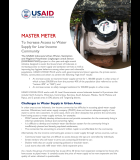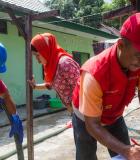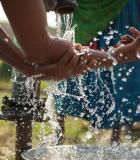High Five Kelurahan Program (High 5)
Diarrhea is a major public health problem in Indonesia. The national prevalence of diarrhea is 11 percent, and it is one of the biggest killers of children under five. Multiple studies (eg. Fewtrel L et al., 2005; Curtis, 2003) suggest that hygiene and sanitation practices are important keys to reduce diarrhea illness. However, some caregivers are not practicing these behaviors, consequently placing infants and children at risk. For example, while toilet use is very common in urban areas, it was discovered that more than 60% of toilets in urban areas channelled feces to poor sanitary facilities or to open spaces (i.e. river, drainage, stream) or even unsafe (leaking) septic tanks (EHRA-ISSDP, National Analysis Report; 2007). As for hand washing with soap, it was reported that more than 95% of mothers in South Sulawesi, East Java and North Sumatera --three of USAID’s target provinces-- washed their hands before preparing meals, but it was not clear if soap was used (IDHS, 2009). In response to this, the Government of Indonesia has recently launched the Community-based Total Sanitation (Sanitasi Total Berbasis Masyarakat=STBM) strategy, an integrated approach dealing with five key behaviors: Eliminating open defecation; hand washing with soap; household water treatment and safe storage and food management; solid waste management; and waste water management.
Activity Description
High Five developed and applied behavior change communication strategy to create a model of STBM approach toward sanitation and hygiene practices improvement in urban area, and utilized SSK as a reference. High Five encouraged partners at all levels to take part in planning, implementing, monitoring and evaluating the program, incorporated their action plans, which enhanced their sense of ownership of the program.
The goal of the High Five program was to improve hygiene and sanitation practices at the household and community levels, and at the same time to contribute to the achievement of the national STBM strategy. This initiative was estimated to benefit 12,000 households or 48,000 people living in urban area within the period of three years.
Expected Outcomes
- Create an enabling environment by engaging public-private partnerships and communities in developing and implementing plans for improved water supply, sanitation and hygiene;
- Improve sanitation and hygiene behaviors through participatory programming at the community level with stakeholders, social networks and community members;
- Ensure sustainable demand and access for safe water, hygiene and sanitation facilities at the household and community levels through empowered and informed communities advocating for themselves
Actual Outcomes
- Formal inclusion of ‘Kelurahan’ and ‘Kota’ in addition to ‘desa’ and ‘Kabupaten’ in the enacted STBM regulation. Health Ministry Decree no. 3, 2014 as a revision of the decree no. 852 in year 2008.
- Formal inclusion of ‘septic tank’ in Pillar 1 as an indicator of safe and healthy toilet in urban areas for the same decree.
- 36 institutions consisting of NGO, other development programs, Public Private, Sanitarian, universities/academy, health volunteers involved in the Program Activities.
- Reached 17,336 women and 8,863 men in total on community mobilization events





